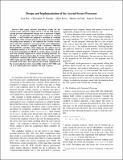Design and Implementation of the Ascend Secure Processor
Author(s)
Ren, Ling; Fletcher, Christopher W; Kwon, Albert; van Dijk, Marten; Devadas, Srinivas
DownloadAccepted version (2.607Mb)
Terms of use
Metadata
Show full item recordAbstract
© 2004-2012 IEEE. This paper presents post-silicon results for the Ascend secure processor, taped out in a 32 nm SOI process. Ascend prevents information leakage over a processor's digital I/O pins-in particular, the processor's requests to external memory-and certifies the program's execution by verifying the integrity of the external memory. In secure processor design, encrypting main memory is not sufficient for security because where and when memory is accessed reveals secret information. To this end, Ascend is equipped with a hardware Oblivious RAM (ORAM) controller, which obfuscates the address bus by reshuffling memory as it is accessed. To our knowledge, Ascend is the first prototyping of ORAM in custom silicon. Ascend has also been carefully engineered to ensure its timing behaviors are independent of user private data. In 32 nm silicon, all security components combined (the ORAM controller, which includes 12 AES rounds and one SHA-3 hash unit) impose a moderate area overhead of 0.51 mm$^2$2. Post tape-out, the security components of the Ascend chip have been successfully tested at 857 MHz and 1.1 V, at which point they consume 299 mW of power.
Date issued
2019Department
Massachusetts Institute of Technology. Department of Electrical Engineering and Computer Science; Massachusetts Institute of Technology. Computer Science and Artificial Intelligence LaboratoryJournal
IEEE Transactions on Dependable and Secure Computing
Publisher
Institute of Electrical and Electronics Engineers (IEEE)